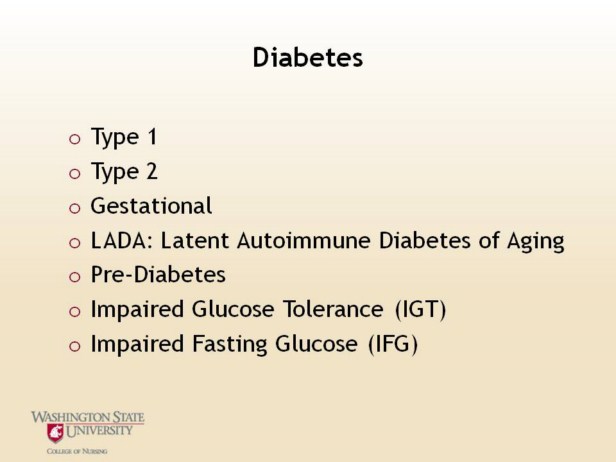| front |1 |2 |3 |4 |5 |6 |7 |8 |9 |10 |11 |12 |13 |14 |15 |16 |17 |18 |19 |20 |21 |22 |23 |24 |25 |26 |review |
 |
1.Type
1 diabetes: Previously known as insulin-dependent (IDDM), juvenile or
childhood-onset. Type 1 is characterized by pancreatic beta cell
destruction. Insulin is not longer produced and the patient is required
to be on insulin.
2.Type
2 diabetes: Previously called non-insulin-dependent (NIDM) or
adult-onset, results from the body’s ineffective use of insulin. Type 2
diabetes comprises 90% of people with diabetes around the world, and is
largely the result of excess body weight and physical inactivity. Type
2 in children is becoming an issue in management.
3. Gestational diabetes (GDM): is hyperglycemia with onset or first recognition during pregnancy. Symptoms of gestational diabetes are similar to Type 2 diabetes. Gestational diabetes is most often diagnosed through prenatal screening, rather than reported symptoms.
4.Latent
Autoimmune Diabetes of Aging (Type 1.5 diabetes): Type 1.5 is one of
several names now applied to
those who are diagnosed with diabetes as adults, but who do not immediately require insulin for treatment, are often not overweight, and have little or no resistance to insulin. When special lab tests are done, they are found to have antibodies, especially GAD65 antibodies, that attack their beta cells.
5.
Pre-Diabetes refers to a person who has a fasting blood sugar of
100-125mg/dl or 5.5-6.875mm. This is the term used by healthcare providers
to say you do not have diabetes yet, but without lifestyle changes, you will
probably go on to develop Type 2 diabetes. Pre-diabetes will also be
referred to as IGT and IFG. For the purpose of this presentation, the focus will be on Type 2 diabetes because of the large percentage of people with diabetes have Type 2 (90%)
Reference: WHO http://www.who.int/diabetes/publications/Definition and diagnosis of diabetes_new.pdf |